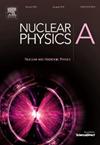Beta decay properties of neutron-rich Co, Ni, Cu and Zn isotopes
IF 2.5
4区 物理与天体物理
Q2 PHYSICS, NUCLEAR
引用次数: 0
Abstract
Accurate and reliable assessments of the β-decay characteristics of neutron-rich nuclei are essential for gaining a deeper insight into the supernova explosions and related nucleosynthesis processes, including the r-process. We calculated the β-decay half-lives, Gamow-Teller distributions and branching ratios of neutron-rich cobalt, nickel and copper isotopes. Stellar weak interaction rates for a total of thirty-six neutron-rich nuclei (72−79Co, 74−83Ni, 78−86Cu and 80−88Zn) were calculated using the proton-neutron quasi-particle random phase approximation (pn-QRPA) model. The computed half-lives are in better agreement with the measured data (having mean deviation of = 1.45) as compared to previous results. The stellar β-decay rates are bigger than the independent particle model rates at low temperature and density values. For high-temperature and high-density zones, the previous rates are up to an order of magnitude bigger than our results. The findings of the current investigation may prove useful for simulation of post-silicon burning evolution of stars and nucleosynthesis calculations.
富中子Co、Ni、Cu和Zn同位素的β衰变特性
准确可靠地评估富中子核的β衰变特征对于深入了解超新星爆炸和相关的核合成过程(包括r过程)至关重要。我们计算了富中子钴、镍和铜同位素的β衰变半衰期、Gamow-Teller分布和分支比。采用质子-中子准粒子随机相近似(pn-QRPA)模型计算了36个富中子核(72−79Co, 74−83Ni, 78−86Cu和80−88Zn)的恒星弱相互作用率。与以前的结果相比,计算的半衰期与测量数据(平均偏差r¯= 1.45)更加吻合。在较低的温度和密度值下,恒星β-衰变速率大于独立粒子模型速率。对于高温和高密度区域,以前的速率比我们的结果大一个数量级。目前的研究结果可能对硅燃烧后恒星演化的模拟和核合成计算有用。
本文章由计算机程序翻译,如有差异,请以英文原文为准。
求助全文
约1分钟内获得全文
求助全文
来源期刊

Nuclear Physics A
物理-物理:核物理
CiteScore
3.60
自引率
7.10%
发文量
113
审稿时长
61 days
期刊介绍:
Nuclear Physics A focuses on the domain of nuclear and hadronic physics and includes the following subsections: Nuclear Structure and Dynamics; Intermediate and High Energy Heavy Ion Physics; Hadronic Physics; Electromagnetic and Weak Interactions; Nuclear Astrophysics. The emphasis is on original research papers. A number of carefully selected and reviewed conference proceedings are published as an integral part of the journal.
 求助内容:
求助内容: 应助结果提醒方式:
应助结果提醒方式:


